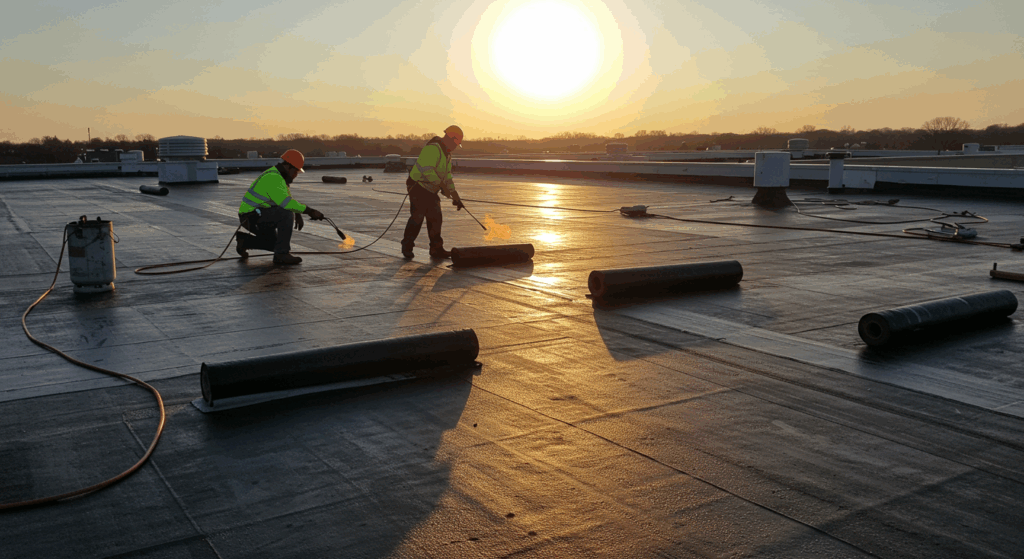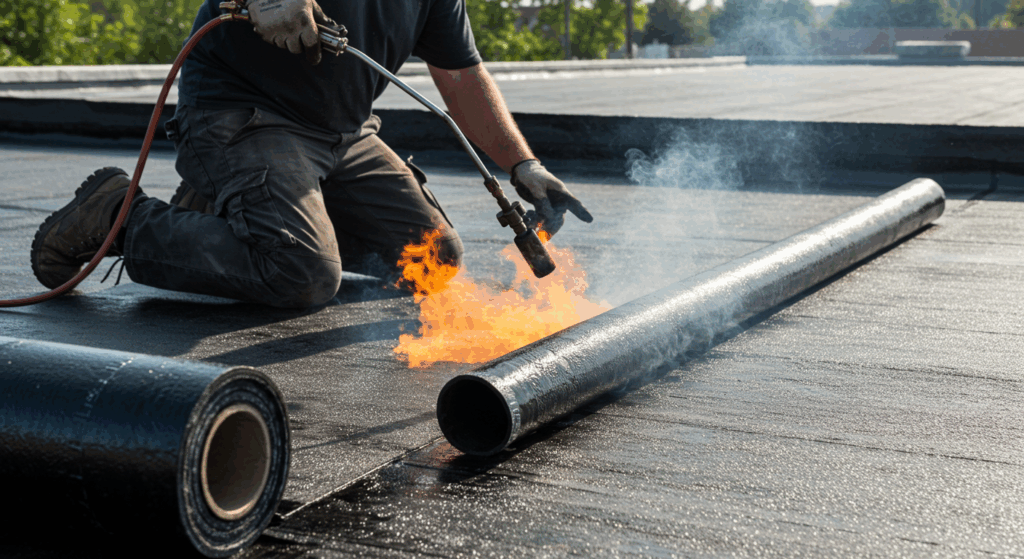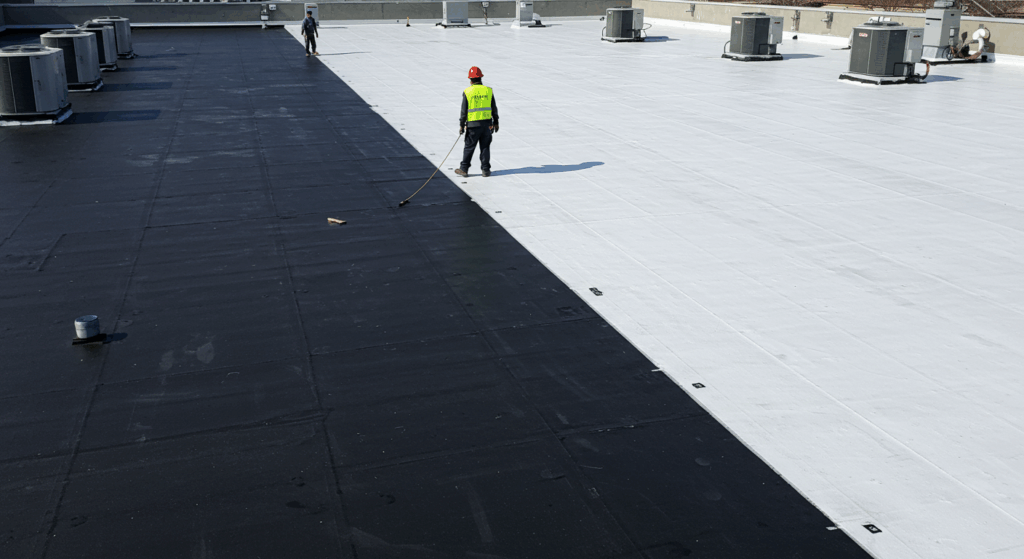Torch Down Roofing: What It Is and When to Use It

When commercial property owners face roofing challenges, they need a solution that combines durability, weather resistance, and long-term value. Torch down roofing has emerged as one of the most reliable options for flat and low-slope commercial roofs, offering superior protection against the elements while providing decades of dependable service.
This modified bitumen roofing system gets its name from the installation process, which involves using a torch to heat and adhere specially manufactured membrane sheets to the roof surface. The result is a seamless, waterproof barrier that can withstand extreme weather conditions, temperature fluctuations, and heavy foot traffic.
This comprehensive guide from Premier Roofing explores what torch down roofing is, how it works, when it’s the right choice for your building, and what you can expect from the installation process. We’ll also examine the long-term benefits and maintenance requirements that make this roofing system a smart choice for many commercial applications.
Understand Torch Down Roofing and How It Protects Flat Roofs
Torch down roofing is a type of modified bitumen roofing system that consists of asphalt-based membrane sheets reinforced with polyester or fiberglass matting. The “torch down” name comes from the installation method, where roofing professionals use propane torches to heat the bottom side of the membrane, activating the adhesive and creating a strong bond with the roof substrate.
The membrane sheets typically measure 3 feet wide and come in rolls of varying lengths, making them manageable for installation teams while ensuring minimal seams. These sheets contain modified asphalt that has been enhanced with rubber or plastic polymers, significantly improving the material’s flexibility, durability, and weather resistance compared to traditional built-up roofing systems.
Modern torch down systems often feature a granulated surface that provides additional protection against UV radiation and physical damage. The granules also offer improved fire resistance and help reflect heat, contributing to better energy efficiency for the building below.
Professional installation teams at Premier Roofing understand that proper surface preparation is crucial for torch down roofing success. The existing roof deck must be clean, dry, and structurally sound before installation begins. Any damaged areas require repair, and the surface needs proper priming to ensure optimal adhesion of the new membrane system.
Explore the Core Materials That Strengthen Torch Down Roofing Systems
The torch down roofing system consists of several critical components that work together to create a comprehensive waterproofing solution. The base sheet serves as the foundation layer, typically featuring a smooth surface that bonds directly to the roof deck or insulation board. This layer provides the initial waterproof barrier and creates a stable platform for subsequent layers.
The cap sheet represents the visible, top layer of the system and includes the granulated surface that protects against UV damage and weather exposure. High-quality cap sheets feature specially formulated granules that resist algae growth, maintain color stability, and provide excellent fire resistance ratings.
Between these layers, installers may apply additional plies depending on the specific system requirements and local climate conditions. Multi-ply systems offer enhanced protection and longer service life, making them ideal for buildings in harsh weather environments or those requiring extended warranty coverage.
The modified asphalt formulation itself represents a significant advancement over traditional roofing materials. Manufacturers typically use APP (Atactic Polypropylene) or SBS (Styrene-Butadiene-Styrene) modifiers to enhance the asphalt’s performance characteristics. APP-modified systems excel in high-temperature environments, while SBS-modified materials perform better in areas with significant temperature fluctuations.
Quality torch down systems also incorporate reinforcement materials such as polyester or fiberglass matting within the membrane structure. These reinforcements provide dimensional stability, prevent tearing during installation and service, and contribute to the overall strength of the finished roof system.
Ensure a Durable Roof with the Right Installation Process

The torch down installation process requires skilled professionals with specialized equipment and extensive safety training. Installation teams begin by thoroughly inspecting and preparing the existing roof surface, addressing any structural issues, drainage problems, or damaged areas that could compromise the new system’s performance.
Surface preparation includes cleaning debris, removing loose materials, and ensuring proper slope for water drainage. Installers apply primer to porous surfaces, creating optimal conditions for membrane adhesion. Proper preparation directly impacts the system’s longevity and performance, making this phase critical to project success.
The actual torch application requires precise temperature control and timing. Professional installers heat the membrane’s bottom surface until the modified asphalt reaches the proper consistency for bonding, then immediately position and roll the material to eliminate air bubbles and ensure complete adhesion. This process demands experience and skill to avoid overheating, which can damage the membrane, or underheating, which results in poor adhesion.
Seam treatment represents another critical aspect of torch down installation. Overlapping edges require careful heating and sealing to create watertight joints that won’t fail under thermal stress or weather exposure. Experienced installation teams pay special attention to these details, understanding that seam failures account for many roofing problems in inferior installations.
Safety protocols during torch down installation are extensive and non-negotiable. Professional crews maintain fire safety equipment on-site, follow strict hot work procedures, and coordinate with building management to protect occupants and property during the installation process.
Know When Torch Down Roofing Is the Best Fit for Your Building
Torch down roofing excels in specific applications where its unique characteristics provide optimal value and performance. Commercial buildings with flat or low-slope roofs represent the primary market for this roofing system, particularly when the structure requires a durable, long-lasting solution that can handle foot traffic and mechanical equipment.
Buildings in climates with extreme temperature variations benefit significantly from torch down roofing’s flexibility and thermal cycling resistance. The modified asphalt formulation expands and contracts with temperature changes without cracking or losing adhesion, making it ideal for regions that experience both hot summers and cold winters.
Property owners seeking energy-efficient roofing solutions find torch down systems attractive due to their reflective granule surfaces and compatibility with various insulation systems. The seamless membrane eliminates thermal bridging that can occur with mechanical fastening systems, contributing to improved building energy performance.
Torch down roofing also works well for buildings that require immediate weather protection during construction or renovation projects. The system can be installed in sections, allowing occupied buildings to maintain weather protection throughout the roofing process.
A recent project demonstrates the versatility of torch down roofing. A 50,000-square-foot distribution center in Minnesota needed roof replacement after severe hail damage compromised its existing system. The facility’s 24/7 operations required a solution that could be installed without disrupting business activities.
Premier Roofing completed the torch down installation in phases, allowing the warehouse to continue operations while receiving superior weather protection that has performed flawlessly through three harsh winter seasons.
Unlock the Lasting Value of Torch Down Roofing
Torch down roofing offers numerous advantages that make it a preferred choice for many commercial applications. The system’s seamless installation eliminates the mechanical penetrations required by other roofing types, reducing potential leak points and improving overall weather resistance.
The membrane’s flexibility allows it to accommodate building movement and thermal expansion without cracking or separating. This resilience translates to fewer maintenance issues and extended service life compared to rigid roofing materials that may fail under stress.
Torch down systems provide excellent resistance to ponding water, a common challenge for flat commercial roofs. The membrane’s composition and seamless installation create a barrier that maintains integrity even when water stands on the surface for extended periods due to drainage issues or heavy rainfall.
Fire resistance represents another significant advantage of modern torch down roofing systems. Quality membranes achieve Class A fire ratings, providing building occupants and property owners with enhanced safety and often qualifying for insurance premium reductions.
The installation versatility of torch down roofing allows it to conform to complex roof configurations, including areas around penetrations, equipment, and architectural features. This adaptability reduces the need for custom flashings and specialized accessories, simplifying installation and reducing potential failure points.
Long-term cost effectiveness makes torch down roofing attractive to budget-conscious property owners. While initial installation costs may exceed some alternatives, the system’s durability and low maintenance requirements often result in lower total cost of ownership over the roof’s service life.
Extend Roof Life with Proactive Maintenance
Proper maintenance plays a crucial role in maximizing torch down roofing performance and service life. Regular inspections, typically conducted twice annually and after severe weather events, help identify potential issues before they develop into costly problems.
These inspections should focus on seam integrity, surface condition, and drainage system performance. Routine maintenance tasks include keeping the roof surface clean and free of debris that could trap moisture or cause physical damage.
Ponding water areas require attention to ensure proper drainage and prevent premature membrane deterioration. Property managers should also monitor and maintain roof penetrations, ensuring that seals around vents, equipment, and other roof-mounted items remain watertight.
Professional maintenance programs often include periodic recoating or granule replacement to extend the membrane’s UV protection and maintain optimal performance. These preventive measures cost significantly less than premature roof replacement and help property owners realize the full value of their roofing investment.
Well-maintained torch down roofing systems typically provide 15-25 years of reliable service, with some installations exceeding 30 years when properly installed and maintained. The system’s performance depends on factors including climate conditions, building use, maintenance quality, and installation workmanship.
Warranty coverage for torch down roofing varies by manufacturer and installation contractor, with options ranging from basic material warranties to comprehensive system warranties that include labor and consequential damage protection. Property owners should carefully review warranty terms and ensure they understand maintenance requirements that may affect coverage.
Comparing Torch Down to Other Roofing Systems

When evaluating roofing options, property owners often compare torch down systems to alternatives such as TPO, EPDM, and built-up roofing. Each system offers distinct advantages and limitations that make them suitable for different applications and budgets.
TPO (Thermoplastic Polyolefin) roofing provides excellent energy efficiency and chemical resistance but may not offer the same durability as torch down systems in high-traffic applications. TPO installation relies on mechanical fasteners or adhesives, creating potential failure points that torch down systems avoid through their seamless installation method.
EPDM (Ethylene Propylene Diene Monomer) rubber roofing offers good weather resistance and flexibility but typically requires more seams and mechanical fasteners than torch down installations. While EPDM may have lower initial costs, the additional penetrations and seams can result in higher long-term maintenance requirements.
Built-up roofing systems use multiple layers of asphalt and reinforcement materials but require hot asphalt application, which creates safety and environmental concerns that torch down installation avoids. Modern torch down systems also offer superior weather resistance and flexibility compared to traditional built-up roofing.
Metal roofing provides excellent longevity and weather resistance, but may not be suitable for all building types or architectural requirements. The higher initial cost of metal systems may not be justified for buildings with shorter anticipated service lives or limited budgets.
The choice between roofing systems ultimately depends on specific building requirements, climate conditions, budget constraints, and long-term facility plans. Professional roofing contractors can provide detailed comparisons and recommendations based on individual project needs.
Frequently Asked Questions
How long does torch down roofing typically last?
Torch down roofing systems typically provide 15-25 years of reliable service when properly installed and maintained. Some installations exceed 30 years in favorable conditions with excellent maintenance programs.
The actual service life depends on factors including climate conditions, building use, maintenance quality, installation workmanship, and the specific membrane system selected. Regular inspections and preventive maintenance significantly impact longevity, helping property owners realize maximum value from their roofing investment.
Is torch down roofing safe during installation?
Professional torch down installation is safe when performed by experienced, trained crews following proper safety protocols. Certified installers maintain fire safety equipment on-site, follow strict hot work procedures, and coordinate with building management to protect occupants and property.
While the installation process involves open flames, professional contractors have extensive experience managing these risks safely. Property owners should only work with licensed, insured contractors who demonstrate proper safety training and equipment.
Can torch down roofing be installed over existing roofing materials?
Torch down roofing can often be installed over existing roofing materials, depending on the condition and type of the existing system. However, this decision requires professional evaluation of the roof structure, existing material condition, and local building codes.
Installing over existing materials can reduce project costs and waste disposal requirements, but may not be appropriate in all situations. A qualified roofing contractor should assess each project individually to determine the best approach.
How does the weather affect torch down roofing installation?
Weather conditions significantly impact torch down installation scheduling and quality. Installation requires dry conditions and moderate temperatures for optimal results. High winds, precipitation, or extreme temperatures can delay installation or compromise membrane adhesion.
Professional contractors monitor weather forecasts carefully and may suspend work when conditions are unfavorable. While this may extend project timelines, proper weather considerations ensure optimal installation quality and long-term performance.
What maintenance does torch down roofing require?
Torch down roofing maintenance includes regular inspections, typically twice annually, and after severe weather events. Routine tasks involve keeping the roof surface clean and free of debris, ensuring proper drainage, and monitoring seam integrity.
Professional maintenance may include periodic recoating or granule replacement to extend UV protection. Prompt attention to minor issues prevents costly repairs and helps maintain warranty coverage. Property owners should establish maintenance relationships with qualified roofing professionals to ensure proper care.
Plan for Long-Term Roof Protection with Trusted Local Support
Torch down roofing represents a proven, reliable solution for commercial buildings requiring durable, weather-resistant protection. Its seamless installation, flexibility, and long-term performance make it an excellent choice for flat and low-slope applications where traditional roofing systems may fall short.
The system’s ability to withstand extreme weather conditions, accommodate building movement, and provide decades of dependable service offers exceptional value for property owners who prioritize quality and longevity.
When properly installed and maintained, torch down roofing delivers the protection and peace of mind that commercial properties demand, making it a smart investment for facilities requiring superior roofing performance.
About Premier Roofing
Premier Roofing specializes in commercial roofing solutions with over two decades of experience serving property owners, facility managers, and commercial developers throughout the region. We provide comprehensive roofing services, including torch down installation, modified bitumen systems, and flat roof restoration.
We pride ourselves on quality workmanship, safety excellence, and customer satisfaction, having helped hundreds of clients achieve reliable roofing performance for their facilities. Our services include new roof installation, roof replacement, emergency repairs, and preventive maintenance programs designed to maximize roof service life and minimize total ownership costs.Contact our team today to discuss how our commercial roofing expertise can help you achieve superior weather protection and long-term value. Schedule a consultation to learn more about our torch down roofing services and how we’ve helped clients achieve decades of reliable roof performance.
